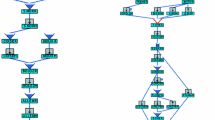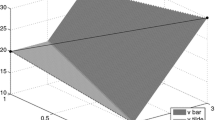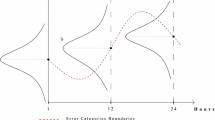Abstract
In this second portion of a two-part analysis of a scalable computational approach to stochastic unit commitment (SUC), we focus on solving stochastic mixed-integer programs in tractable run-times. Our solution technique is based on Rockafellar and Wets’ progressive hedging algorithm, a scenario-based decomposition strategy for solving stochastic programs. To achieve high-quality solutions in tractable run-times, we describe critical, novel customizations of the progressive hedging algorithm for SUC. Using a variant of the WECC-240 test case with 85 thermal generation units, we demonstrate the ability of our approach to solve realistic, moderate-scale SUC problems with reasonable numbers of scenarios in no more than 15 min of wall clock time on commodity compute platforms. Further, we demonstrate that the resulting solutions are high-quality, with costs typically within 1–2.5 % of optimal. For larger test cases with 170 and 340 thermal generators, we are able to obtain solutions of similar quality in no more than 25 min of wall clock time. A major component of our contribution is the public release of the optimization model, associated test cases, and algorithm results, in order to establish a rigorous baseline for both solution quality and run times of SUC solvers.
Similar content being viewed by others
References
Caroe, C., Schultz, R.: Dual decomposition in stochastic integer programming. Oper. Res. Lett. 24(1–2), 37–45 (1999)
Carrion, M., Arroyo, J.: A computationally efficient mixed-integer linear formulation for the thermal unit commitment problem. IEEE Trans. Power Syst. 21(3), 1371–1378 (2006)
Cerisola, S., Baillo, A., Fernandez-Lopez, J.M., Ramos, A., Gollmer, R.: Stochastic power generation unit commitment in electricity markets: a novel formulation and a comparison of solution methods. Oper. Res. 57, 32–46 (2009)
Danna, E., Rothberg, E., Pape, C.L.: Exploring relaxation induced neighborhoods to improve MIP solutions. Math. Program. 102(1), 71–90 (2005)
eTerraMarket. http://www.alstom.com. Accessed Apr 2015 (2014)
Feng, Y., Rios, I., Ryan, S.M., Spurkel, K., Watson, J.-P., Wets, R.J.-B., Woodruff, D.L.: Toward scalable stochastic unit commitment. Part 1: load scenario generation. Energy Syst. (2015). doi:10.1007/s12667-015-0146-8
Gade, D., Hackebeil, G., Ryan, S.M., Watson, J.-P., Wets, R.J.-B., Woodruff, D.L.: Obtaining lower bounds from the progressive hedging algorithm for stochastic mixed-integer programs. (2015). http://www.optimization-online.org/DB_HTML/2015/01/4728.html
Goez, J., Luedtke, J., Rajan, D., Kalagnanam, J.: Stochastic unit commitment problem. Tech. rep., IBM (2008)
Hart, W., Watson, J., Woodruff, D.: Pyomo: Modeling and solving mathematical programs in Python. Math. Program. Comput. 3(3), 219–260 (2011)
Morales-Espana, G., Latorre, J.M., Ramos, A.: Tight and compact MILP formulation for the thermal unit commitment problem. IEEE Trans. Power Syst. 21, 4897–4908 (2013)
Oren, S., Papavasiliou, A., O’Neil, R.: Reserve requirements for wind power integration: a scenario-based stochastic programming framework. IEEE Trans. Power Syst. 26(4), 2197–2206 (2011)
Oren, S., Papavasiliou, A., O’Neil, R.: Multi-area stochasti c unit commitment for high wind penetration in a transmission-constrained network. Oper. Res. 61(3) (2013)
Ostrowski, J., Anjos, M., Vanneli, A.: Tight mixed integer linear programming formulations for the unit commitment problem. IEEE Trans. Power Syst. 27(1), 39–46 (2012)
Papavasiliou, A.: Coupling renewable energy supply with deferrable demand. Ph.D. thesis, University of California Berkeley (2011)
Papavasiliou, A., Oren, S.: A stochastic unit commitment model for integrating renewable supply and demand response. In: Proceedings of the 2012 IEEE Power and Energy Society Meeting (2012)
Price, J.: Reduced network modeling of WECC as a market design prototype. In: Proceedings of the 2011 IEEE Power and Energy Society General Meeting (2011)
Rockafellar, R., Wets, R.J.B.: Scenarios and policy aggregation in optimization under uncertainty. In: Mathematics of Operations Research, pp. 119–147 (1991)
Ruiz, P., Philbrick, C., Sauer, P.: Modeling approaches for computational cost reduction in stochastic unit commitment formulations. IEEE Trans. Power Syst. 25(1), 588–589 (2010)
Ruiz, P., Philbrick, R., Zack, E., Cheung, K., Sauer, P.: Uncertainty management in the unit commitment problem. IEEE Trans. Power Syst. 24(2), 642–651 (2009)
Shapiro, A., Dentcheva, D., Ruszczyński, A.: Lectures on stochastic programming: modeling and theory. Society for Industrial and Applied Mathematics (SIAM), Philadelphia (2009)
Siface, D., Vespucci, M., Gelmini, A.: Solution of the mixed integer large scale unit commitment problem by means of a continuous stochastic linear programming model. Energy Syst. 5(2), 269–284 (2014). doi:10.1007/s12667-013-0107-z
Slyke, R.V., Wets, R.: L-shaped linear programs with applications to optimal control and stochastic programming. SIAM J. Appl. Math. 17, 638–663 (1969)
Takriti, S., Birge, J., Long, E.: A stochastic model for the unit commitment problem. IEEE Trans. Power Syst. 11(3), 1497–1508 (1996)
Watson, J., Woodruff, D.: Progressive hedging innovations for a class of stochastic mixed-integer resource allocation problems. Comput. Manag. Sci. 8(4), 355–370 (2011)
Watson, J.P., Woodruff, D., Hart, W.: PySp: modeling and solving stochastic programs in Python. Math. Program. Comput. 4(2), 109–149 (2012)
Zheng, Q., Wang, J., Pardalos, P., Guan, Y.: A decomposition approach to the two-stage stochastic unit commitment problem. Ann. Oper. Res. 210(4), 387–410 (2013)
Acknowledgments
Sandia National Laboratories is a multi-program laboratory managed and operated by Sandia Corporation, a wholly owned subsidiary of Lockheed Martin Corporation, for the US Department of Energy’s National Nuclear Security Administration under Contract DE-AC04-94-AL85000. This work was funded by the Department of Energy’s Advanced Research Projects Agency-Energy, under the Green Energy Network Integration (GENI) project portfolio, and by Sandia’s Laboratory Directed Research and Development program.
Author information
Authors and Affiliations
Corresponding author
Rights and permissions
About this article
Cite this article
Cheung, K., Gade, D., Silva-Monroy, C. et al. Toward scalable stochastic unit commitment. Energy Syst 6, 417–438 (2015). https://doi.org/10.1007/s12667-015-0148-6
Received:
Accepted:
Published:
Issue Date:
DOI: https://doi.org/10.1007/s12667-015-0148-6




